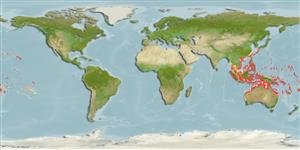Common names from other countries
Environment: milieu / climate zone / depth range / distribution range
Écologie
marin récifal; non migrateur; profondeur 1 - 50 m (Ref. 1602). Tropical; 32°N - 32°S, 96°E - 136°W
Eastern Central Indian Ocean to Western Pacific: : Cocos-Keeling Islands in the eastern Indian Ocean to Samoa and the Line Islands, north to southern Japan, south to Rowley Shoals (eastern Indian Ocean) and Lord Howe Island (Ref. 37816). Not found in the Hawaiian and Society islands and islands beyond. Replaced by Dascyllus carneus in the Indian Ocean (Ref. 37816).
Taille / Poids / Âge
Maturity: Lm ? range ? - ? cm
Max length : 9.0 cm TL mâle / non sexé; (Ref. 30874)
Épines dorsales (Total): 12; Rayons mous dorsaux (Total): 14-16; Épines anales 2; Rayons mous anaux: 12 - 14. Color variable according to ecological and behavioral conditions: basically body whitish with snout, interorbital and forehead greenish; black bar on anterior and a fainter one on posterior part of the body; blackish scale margins; pelvic fins mostly black; pectorals transparent with a spot on its base. Margins of preorbital, suborbital, and preoperculum finely serrated (Ref. 2746). Body depth 1.4-1.6 in SL (Ref. 90102).
Adults occur in outer lagoon and seaward reefs. They inhabit branching coral heads, particularly Pocillopora eydouxi. Form schools, often in silty habitats (Ref. 48636). Male prepares a nest by cleaning with its mouth a rock or coral surface where the female will attach the eggs (Ref. 5503). Oviparous, distinct pairing during breeding (Ref. 205). Diurnal species (Ref. 54980; 113699).
Life cycle and mating behavior
Maturité | Reproduction | Frai | Œufs | Fécondité | Larves
Benthic spawner. Oviparous, distinct pairing during breeding (Ref. 205). Eggs are demersal and adhere to the substrate (Ref. 205). Males guard and aerate the eggs (Ref. 205). Also Ref. 103751.
Randall, H.A. and G.R. Allen, 1977. A revision of the damselfish genus Dascyllus (Pomacentridae) with description of a new species. Rec. Aust. Mus. 31(9):349-385. (Ref. 2746)
Statut dans la liste rouge de l'IUCN (Ref. 130435)
CITES (Ref. 128078)
Not Evaluated
Menace pour l'homme
Harmless
Utilisations par l'homme
Pêcheries: intérêt commercial mineur; Aquarium: Commercial
Plus d'informations
RéférencesAquacultureProfil d'aquacultureSouchesGénétiqueElectrophoresesHéritabilitéPathologiesTraitementMass conversion
Outils
Articles particuliers
Télécharger en XML
Sources Internet
Estimates based on models
Preferred temperature (Ref.
115969): 24.6 - 28.9, mean 27.6 (based on 448 cells).
Phylogenetic diversity index (Ref.
82804): PD
50 = 0.5005 [Uniqueness, from 0.5 = low to 2.0 = high].
Bayesian length-weight: a=0.02951 (0.01709 - 0.05095), b=2.99 (2.84 - 3.14), in cm Total Length, based on LWR estimates for this species & (Sub)family-body (Ref.
93245).
Niveau trophique (Ref.
69278): 3.1 ±0.31 se; based on food items.
Résilience (Ref.
120179): Haut, temps minimum de doublement de population inférieur à 15 mois (K=0.5).
Fishing Vulnerability (Ref.
59153): Low vulnerability (25 of 100).
